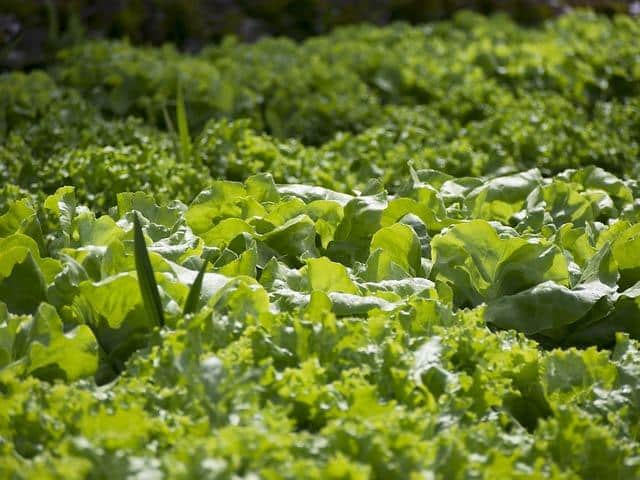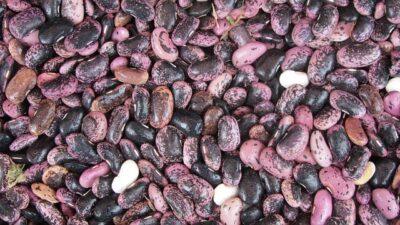It can be hard to decide on crops for sustenance farming, but growing beans is an easy decision. Beans have a long tradition in North America for a reason: They’re easy to grow, can yield large amounts of food, and are packed with nutrition. And if you know how many seeds to plant, you can easily grow enough to just about feed your family for a full year.
As a source of protein, beans are much less labor-intensive to produce than meat, dairy or eggs, and can be a valuable supplement in your diet. They store well, and each successive year of growing and harvesting beans will lead to better yields within your climate.
If you directly compare the nutritional content of black beans and chicken, the result is surprising:
| Black Beans, 100 g | Chicken, 100 g | |
| Calories | 341 | 249 |
| Fat | 1.4 g | 14 g |
| Protein | 22 g | 27 g |
| Dietary Fiber | 16 g | 0 g |
| Calcium | 123 mg | 15 mg |
| Potassium | 1483 mg | 223 mg |
| Iron | 5 mg | 1.3 mg |
| Vitamin B6 | 0.3 mg | 0.4 mg |
| Magnesium | 171 mg | 23 mg |
Comparing other beans and meats yields similar results. The two foods provide an almost equivalent amount of protein, but the beans are more nutrient-rich, by far. It should be noted that the protein in beans is an incomplete protein, and a vegetarian diet would require additional plant proteins such as whole grains or nuts eaten through the day to provide all the amino acids needed for the body.
Need Non-GMO Heirloom Beans For Your Spring Garden? The Best Deals Are Right Here!
This is partly why the Native Americans grew beans alongside corn and squash; the “three sisters” together provide nearly all the nutrients the body needs. When you’re using beans to supplement an omnivorous diet, you needn’t worry about that because the meat, dairy and eggs will provide all the complete protein you need. Beans are the go-to food to fill you up and stretch your meals, so they last longer and feed more people.
Choosing and Growing Beans
Select two to three varieties to grow in your first year, based on flavor preferences and the amount of space in your garden. You will need 10-20 plants per person to provide enough beans for a year. Plant beans in early spring, after the last frost, being careful to rotate them through your garden yearly to keep them producing well.
Generally, there are two types of beans commonly grown: shell varieties, which can be eaten fresh or dried, and snap beans, grown mainly for their pods. These categories are subdivided by the growth patterns of the beans: bush or pole. While bush beans can be planted unsupported, pole beans grow on vines which need to be staked to grow effectively; pole beans take up less horizontal space in the garden but require more maintenance during growth to ensure they climb properly. Dry beans are more traditionally used in North America, but snap beans have also been cultivated for centuries. Some plants can provide both types of beans.
Common varieties of beans for home gardens that can be eaten fresh and dried are adzuki beans, black-eyed peas, Fava beans, Lima beans and pinto beans.
The World’s Healthiest Survival Food — And It Stores For YEARS and YEARS!
You can easily experiment with beans to decide which are best suited to your climate and are preferred by your family.
Harvesting, Storing and Cooking Dried Beans
Dry beans are allowed to mature fully on the plant, becoming fully dried before you pick them. After picking, beans must be removed from the pods by threshing; you can beat the individual plants against the inside of a container to release the beans, or use a bean flail to hit the beans on a cloth and break the pods in order to remove the beans. Separating the chaff from the beans by winnowing on a windy day is simple: Simply pour the beans and chaff from one basket to another outdoors several times and let the chaff be carried off by the breeze.
You can store beans for many months or even years, in jars kept in a cool, dry location. If you intend to save some of the beans as seed, let them dry, spread out, four to six weeks before storing them in jars, until the beans are fully hardened and cannot be broken by biting them. Dry beans require soaking before cooking. Allow the beans to soak in cool water overnight before using in soups, as side dishes, or mixed with grains for a meal. Growing dry beans for storage is like saving up for the future; no matter what happens in your garden and with your livestock in the coming year, you will have a source of nutrition at hand, ready to feed your family.
Related:
The Three Sisters: How To Garden The ‘Native American Way’
What are your bean-growing tips? How many do you plant to feed your family? Share your advice in the section below:
Every Spring, Gardeners Make This Avoidable Mistake — But You Don’t Have To. Read More Here.
 Off The Grid News Better Ideas For Off The Grid Living
Off The Grid News Better Ideas For Off The Grid Living





